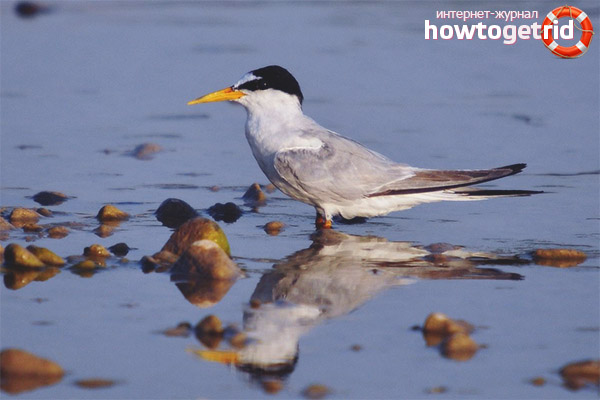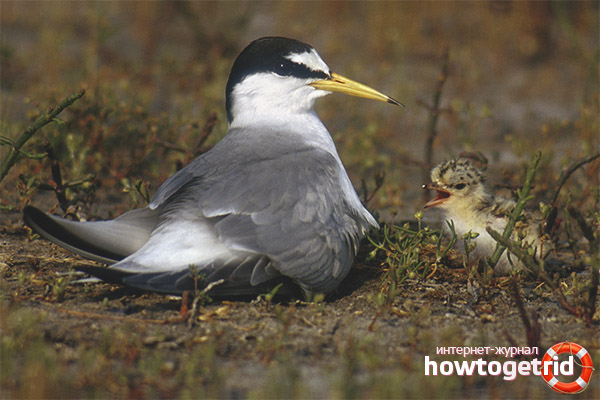The content of the article
The number of terns is small, but the habitat extends widely, capturing almost all European countries, as well as Denmark, Sweden, Bulgaria. Her slightly fussy behavior and part melodious voice make her smile. Her habits include a frequent change of plumage, depending on age and season. Krachka belongs to migratory birds and prefers to spend the winter months in warm countries, annually traveling in the fall "to the resort" in West Africa, India and the Persian Gulf.
Noisy inhabitant of the sea shore
A small tern in size does not exceed a starling, and it has enough energy and enthusiasm for everyone. A distinctive feature is a white forehead and strips above the eyebrows. The back is gray, the color of the abdomen is lighter. A bright yellow beak with a neat black tip is striking. It is quite sharp, as the bird is fishing, diving at it from above.
Krachka changes his outfit several times in his life. Chicks are covered with light fluff with dark spots. It ranges from yellowish gray to sand. The bill is pinkish with a darker tip. Growing up, the tern changes fluff to the first outfit, which is distinguished by the predominance of light colors and an incomplete hat of a dark color on the crown of the bird. Twice more, she will change plumage until she reaches breeding age.
Krachki calmly endure the neighborhood with humans, the habitat is gradually expanding, and birds are developing new territories. Birds migrate in small groups, less often there are paired migrations, sometimes loners can be observed.
- small fish and fry;
- insects
- invertebrates;
- shrimp
- small crustaceans.
To get food, the tern folds its wings and dives into the water, sometimes leaving to a depth of several meters. It is interesting to observe how, in search of food, a bird literally freezes in the air, fluttering its wings finely, and then breaks into a rapid fall, emerging with prey.
Mating and care for offspring
The male has been courting the female for a long time, flaunting in front of her on land and demonstrating miracles on bends in the air, often the couple starts flying around the territory, keeping close to each other. It does not take much time to build a nest, since it is a shallow hole in the ground, slightly covered with twigs, small pebbles and empty shells. From May to June, depending on the weather in the region, egg laying begins.
As a rule, there are 3 eggs in a nest, less often there are nests with 4 or 5 eggs. A mottled, sandy - buffy color with a random scattering of spots successfully masks eggs on the ground. Both parents take turns sitting on the nest. The male, like a true gentleman, feeds the female. The most troublesome time comes from the moment the chicks hatch. They have to be fed up to 63 times a day. But they soon become independent and can hide when natural enemies appear. These include tea-nosed terns eating young and eggs, gulls, kestrels, jackal foxes. With so many lovers, it is not surprising that terns learned to grow up quickly in the process of evolution. Already at the age of 1-2 days they run up and hide in case of alarm in a bird colony. By day 21, the young stand on the wing and disperse along the coastal line.
Interesting Facts
- Caring parents continue to feed the grown chicks until the fall flight.
- Sometimes there are nests - dormitories, where there are 7 - 9 eggs from several clutches.
- Chicks grow up very early, at the age of three days they already go for a walk around the nest.
- The bird’s voice is quite melodic without creaking and rattle.
- Krachka leads a daily life, but is able to continue to get food even in the thick twilight.
The little tern has learned to live next to a person, but often thoughtless economic activity causes significant damage to their livestock. Birds save high mobility, they are looking for new fertile places for life and nesting.
Video: Tern (Sternula albifrons)











Submit